Sunday, March 27, 2022
This article has been syndicated for US distribution. What does it mean that this article is “ syndicated”? See end of article for explanation.
Practical Considerations for Applying
VandlGuard IsoFree Aliphatic Urethan 2K
Anti-Graffiti Coating To New Murals
By Scott M. Haskins, Mural Conservator
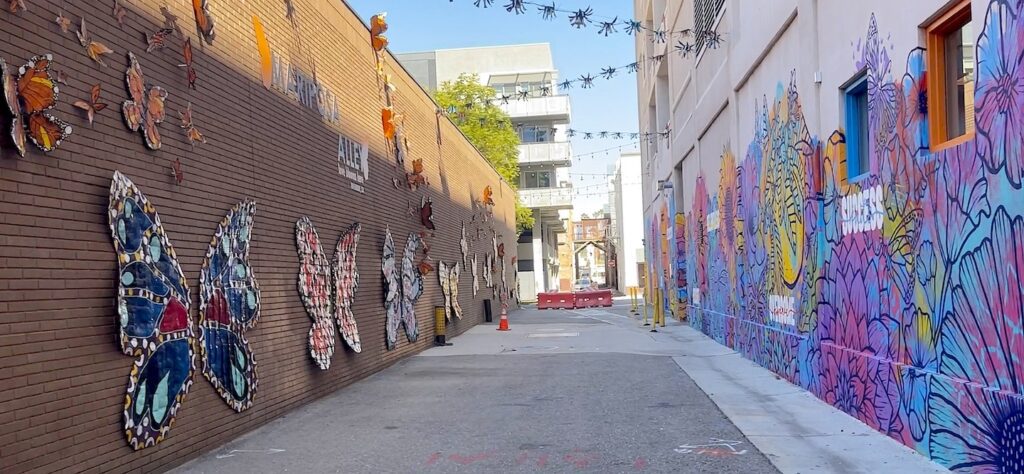 A recent project manager inquired, wanting to protect and preserve a new mural, located in Los Angeles CA and called to consult with me, Scott M. Haskins, Art (Mural) Conservator who is contracted with the Los Angeles Department of Cultural Affairs as their mural restoration expert. The mural was painted in acrylic paint medium directly onto the side of a building, the wall measured 30’ high x 90’ wide, was at ground level in kind of an alleyway, exposed to direct sun for a couple of hours a day. Part of the mural is accessible by the public off the street at all times of the day or night. Graffiti protection was the main motivation for the inquiry.
A recent project manager inquired, wanting to protect and preserve a new mural, located in Los Angeles CA and called to consult with me, Scott M. Haskins, Art (Mural) Conservator who is contracted with the Los Angeles Department of Cultural Affairs as their mural restoration expert. The mural was painted in acrylic paint medium directly onto the side of a building, the wall measured 30’ high x 90’ wide, was at ground level in kind of an alleyway, exposed to direct sun for a couple of hours a day. Part of the mural is accessible by the public off the street at all times of the day or night. Graffiti protection was the main motivation for the inquiry.

I recommended the product, made specifically for mural protection, a 2 part Aliphatic PolyUrethane resin which has been tested and analyzed by Caltrans and the Los Angeles Department of Cultural Affairs (DCA) for the protection and maintenance of outdoor murals over the last 20 years. For reasons of quality of product and quality of customer service, I recommend the product by RainGuard and designated as VandlGuard IsoFree Aliphatic Urethane 2K.
Once the two parts are mixed, Rainguard says you have a pot life of 3-4 hours to apply the product before it begins to coagulate (it starts to look like cottage cheese and is unusable). But I’ve found that actually, in practical terms, you have about 1 ½ hrs for the application of the product until the mixture begins to harden. The surface will be dry enough for recoating after 4 – 8 hours. Coalescence cure time is 3-7 days.
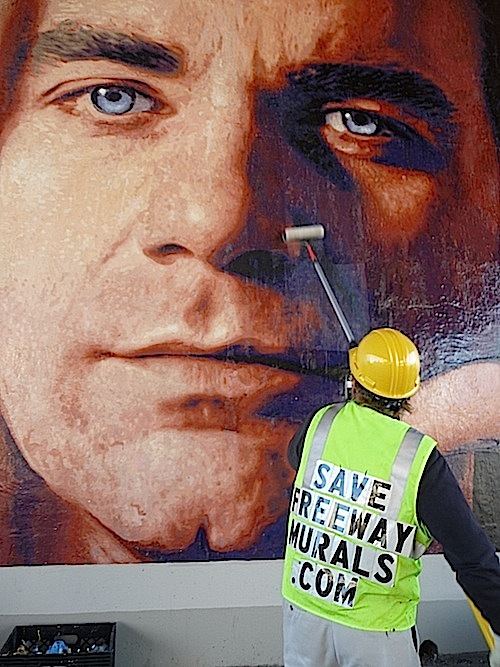
This mural’s existence over the decades can be attributed to the protective varnish layers.
The product data page affirms; “UV resistant, strong graffiti protection. Will not yellow. Direct-to-metal and concrete applications. Chemical and acid resistant. Water based, it contains Zero VOC, no carcinogens, no odor and can be applied on exterior surfaces and interior OEM environments. Warranty up to 10 years with a single coat, and up to 15 years with a second coat.” For more about the product and use from the manufacturer, click here.
This article presents a practical example of use
by an experienced mural conservation expert.
There are many conditions and circumstances that will vary and will require a variety of different applications of the product in order to adequately protect a mural and to maintain it more easily in the future. The manufacturer states that one application of the product is enough for adequate protection. But my experience is that this is an over-simplification.
Most large murals have areas out of reach of vandals and may be adequately protected with one application of protection. But the areas of a mural that are within reach by taggers and more at risk (maybe only 1/3 of the mural?) will require at least 2 applications and I recommend 4 applications if the mural is in a “war zone.”
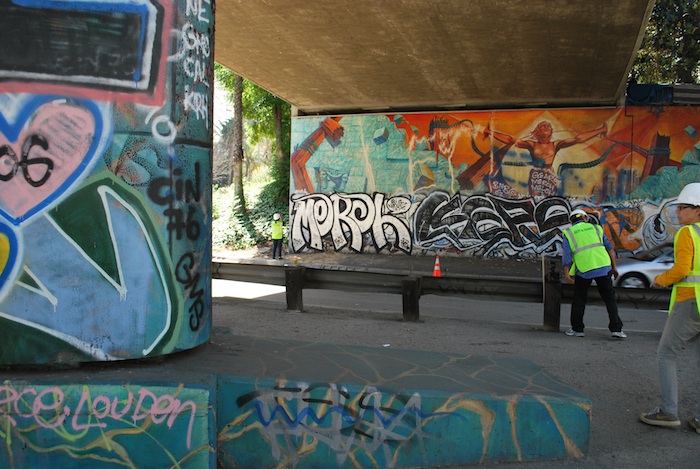
Gorgeous murals overcome, but well protected, by the varnish layers
Keep in mind also that there are many different kinds of spray paint, some of which are harder to re-dissolve and remove than others (which will ultimately be destructive to the mural’s paint layers). The removal of graffiti is complicated by how many layers have accumulated on the surface, one over the other. If you suspect that the mural will not be maintained and cleaned immediately when tagged, then more protection is needed in order to make the mural more resistant to the cleaning agents in the future.
The thickness of the paint application on the mural (thicker is better like on Judy Bacca’s mural in the photo above) and the texture of the wall (smoother is better) both make future cleaning more or less difficult and more or less successful. Consider that when varnishing a mural painted with acrylic paint, the varnish becomes part of the mural, making its removal very difficult or impossible without redissolving the mural’s paint layers. So, applying the varnish or protection layer in a manner to make it as resistant as possible during future cleaning is imperative to the future health of the mural.

This layers of paint with no protection are susceptible to the elements quickly.
Details to consider when forecasting the costs and time required:
- Number of applications/coats x the sq. footage (1 gal covers about 400 sq ft)
- Remember you have about 1 ½ hrs pot life for use after you mix the 2 components (don’t mix them and then go to lunch!).
- Coating can be applied with a sprayer (immediate thorough cleaning of spray equipment after each use is essential) or rolled on or with a brush. Discard used materials.
- You can’t apply VandlGuard IsoFree too thick, all at once, as it will drip/run. Multiple thinner coats will give a much more beautiful finish.
Notes On An Application
In the case mentioned at the beginning of this article, the entire (30’ x 90’) mural would receive 1 substantial coating, spray applied. In addition, the lower 10’ area of the 30’ x 30’ area of mural outside the gated area would receive 3 additional coats (same application technique), which is considered more at risk of being tagged.
The application of the water base anti-graffiti protection layers appears slightly milky when freshly applied and a single application goes clear quickly (15 -30 minutes) but remains sticky until dry. Wait a few hours for a reapplication. This, of course, depends on whether it is a sunny dry day or a humid cool day. See the manufacturers suggestions for proper conditions. We have applied it in very humid weather, even in light sprinkling rain and we had no problems with application of the resin eventually going/drying clear.
Wall texture will make a big difference in application time. Spraying will avoid a lot of texture problems on a rough wall (that can slow you down) vs. a paint roller technique but there are other drawbacks I’ve already discussed. Using a paint roller with the lowest nap may be great on a smooth wall but its not practical on the wall in the photo. Paint brush application would require many increased hours of labor plus continual attention to drips and the dilemma of the pot life.
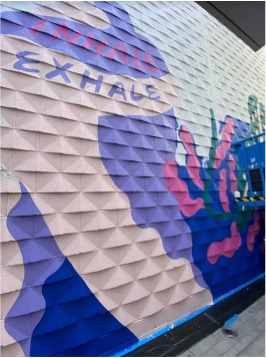
The more textured the wall is, the more product you will consume and the longer it will take to apply.
A Note About Future Maintenance
An anti-graffiti protection layer makes it easier to remove graffiti. It does not keep people from tagging the mural. This is not a magic layer of protection that makes graffiti magically slide off the wall or wash off easily. Graffiti (paint from spray cans) comes in many different qualities. Some are easier to remove than others and some are very hard to remove.
In addition to this anti-graffiti protection layer, upon being tagged, immediate removal of graffiti by building personnel (maintenance) AND REAAPLICATION of anti-graffiti protection will ensure long term, best appearance and mural preservation. Both the anti-graffiti protection layer and the mural can be touched up if damage occurs.
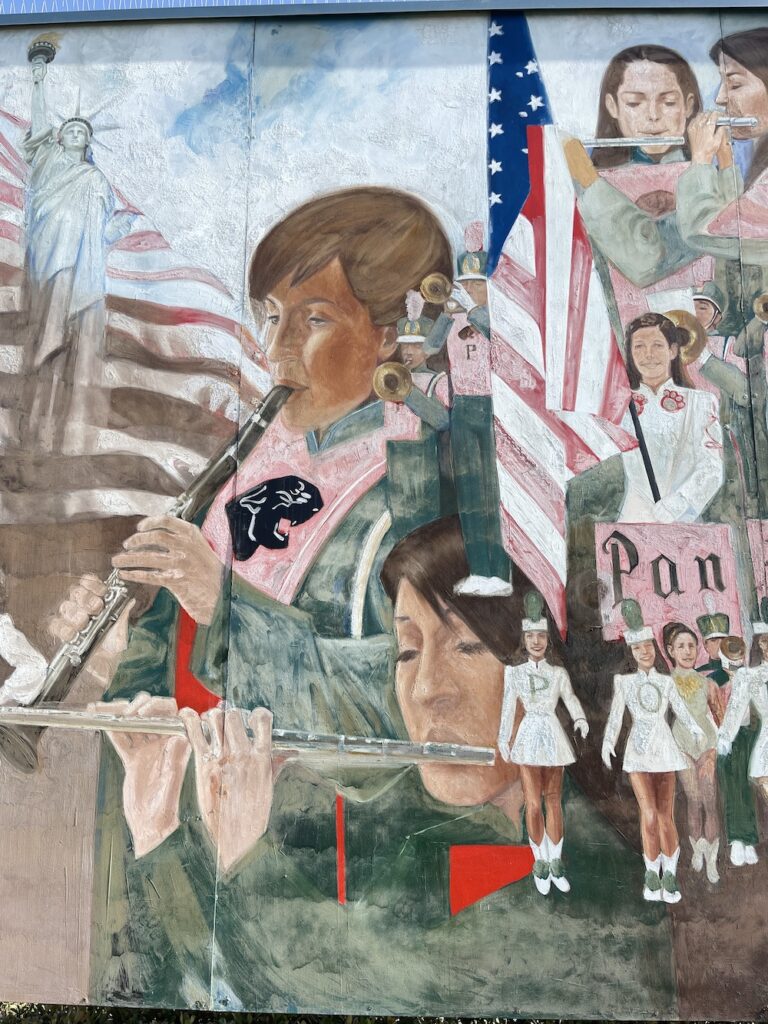
Even if a mural is not at risk of vandalism, should it be varnished? Here a quick practical example of what the weather and hydrolysis can do:
Questions: Scott M. Haskins, Virginia Panizzon Art Conservators, 805 564 3438 faclofficemanager@gmail.com
This blog post has been syndicated at ExpertClick.com. What does it mean that this article is “ syndicated”?
Its a bit of a coup to get an article syndicated, and its certainly prestigious, as additional “proof” that the info and the author are considered far and wide authoritative and an expert in the field. So, enjoy and trust our content!! This article was syndicated for USA national redistribution.
When something is published, usually by a news source, and is made available through different venues for redistribution then it is said to be syndicated. Publications that are syndicated are usually considered of value as being from an expert, educational, new worthy or valuable for wide popular interest. See syndication page at the renowned publicity site: https://www.expertclick.com/NRWire/Releasedetails.aspx?id=269070
This website’s syndication included:
1) Included in the ExpertClick Press Room as a ‘press release.’ (different than a ‘news release’)
2) Included in the ‘Speaker Bureau Platform Page.’
3) Shown on the front page of ExpertClick, in rotation with other most recent posts.
4) Shown in the ‘News Release Results page.’
5) Included on optimized for searches on all my topics of expertise.
6) Shown via RSS linked from the Press Room. (A specific way news is actively distributed within the industry)
7) Shown in the full RSS feed from ExpertClick. (Another, different specific way news is actively distributed within the industry)
8) Syndicated to LexisNexis.com As of 2006, the company had the world’s largest electronic database for legal and public-records related information, distributor of academic content and expert opinion.
This article has been syndicated at https://www.expertclick.com/NRWire/Releasedetails.aspx?id=269070
Scott M. Haskins, Fine Art Conservation Laboratories, 805 564 3438 office, 805 570 4140 mobile, faclartdoc@gmail.com